Archaeologia Lituana ISSN 1392-6748 eISSN 2538-8738
2019, vol. 20, pp. 116–138 DOI: https://doi.org/10.15388/ArchLit.2019.20.5
Hidden, Unwanted or Simply Forgotten? A Bioarchaeological Profile of the Subačius Street 41 Population
Justina Kozakaitė
Department of Archaeology, Faculty of History
7 Universiteto St., LT-01513 Vilnius
Vilnius University, Lithuania
justina.kozakaite@mf.vu.lt
Žydrūnė Miliauskienė
Department of Anatomy, Histology and Anthropology, Faculty of Medicine
21 M. K. Čiurlionio St., LT-03101 Vilnius
Vilnius University, Lithuania
zydrune.miliauskiene@mf.vu.lt
Rūta Brindzaitė
Department of Anatomy, Histology and Anthropology, Faculty of Medicine
21 M. K. Čiurlionio St., LT-03101 Vilnius
Vilnius University, Lithuania
ruta.brindzaite@mf.vu.lt
Abstract. In 2014–2015, an unknown 16th–17th-century cemetery was discovered at the Subačius Street 41 plot in Vilnius. The uncovered human remains are considered to be one of the most abundant and best-preserved anthropological material in the territory of present-day Vilnius. Paradoxically, historical sources do not mention this burial site, although the abundance of the interred individuals does not imply an accidental burial, but perhaps a functioning cemetery for some time. In such exceptional cases, the only source of information is the synthesis of archaeological and anthropological research data.
This article presents preliminary results and a brief overview of bioarchaeological (demographic, paleopathological, and dental research, height reconstruction) investigation. A total of 151 individuals were studied, with almost half (45%) of them consisting of children. Almost 60% of the individuals had one or more pathological lesions. The average height of male individuals was estimated 168.2 cm, the average height of females was 157.8 cm. The aim of this study can be defined as twofold: an attempt to identify the people buried outside the city walls and systematize for the first time the bioarchaeological data of one-out-of-many Vilnius populations. Currently, the Subačius Street 41 population does not resemble a typical urban community, so the study itself is the first attempt to reveal the osteobiography of these 16th–17th century Vilnius residents.
Keywords: paleopathology, dental studies, bioarchaeology, Vilnius, Early modern, population studies.
Slepiami, nepageidaujami ar tiesiog pamiršti? Subačiaus g. 41 populiacijos bioarcheologinis profilis
Anotacija. 2014–2015 m. archeologinių tyrimų metu buvo atrastos iki šiol nežinomos XVI–XVII a. kapinės, esančios Subačiaus g. 41 sklype, Vilniuje. Šios kapinės yra laikytinos vienomis iš gausiausių ir geriausiai išlikusių antropologinės medžiagos atžvilgiu dabartinio Vilniaus miesto teritorijoje. Paradoksalu, tačiau istoriniai šaltiniai neužsimena apie šią laidojimo vietą, nors iškastų palaikų gausa suponuoja ne atsitiktinius palaidojimus, o galbūt kurį laiką funkcionavusias kapines. Neretai tokiais išskirtiniais atvejais vieninteliu informacijos šaltiniu tampa archeologinių ir antropologinių tyrimų duomenų sintezė.
Šiame straipsnyje publikuojami preliminarūs bioarcheologinių tyrimų (demografinių, paleopatologinių, dantų analizės, ūgio rekonstrukcijos) rezultatai ir trumpa jų apžvalga. Iš viso ištirtas 151 individas, kurių didžiąją dalį (45 %) sudarė vaikai.
Šiuo tyrimu siekiama atsakyti į svarbų probleminį klausimą, kas galėtų būti šie asmenys, atsidūrę už tuometinio Vilniaus miesto sienų, ir pabandyti susisteminti vienos gausiausių Vilniaus populiacijų bioarcheologinius duomenis. Kol kas galima tik pasakyti, kad Subačiaus g. 41 populiacija neprimena tipinės miesto bendruomenės, tad pati studija yra vienas pirmųjų bandymų atskleisti šių XVI–XVII a. Vilniaus gyventojų osteobiografiją.
Reikšminiai žodžiai: paleopatologija, dantų tyrimai, bioarcheologija, Vilnius, naujieji laikai, populiacinės studijos.
Received: 24/10/2019. Accepted: 28/11/2019
Copyright © 2019 Justina Kozakaitė, Žydrūnė Miliauskienė, Rūta Brindzaitė. Published by Vilnius University Press
This is an Open Access article distributed under the terms of the Creative Commons Attribution Licence, which permits unrestricted use, distribution, and reproduction in any medium, provided the original author and source are credited.
Introduction
Officially, the history of Vilnius, the capital city of historic and current Lithuania, began in 1323. Back then, Gediminas, the Grand Duke of Lithuania, started to turn Vilnius into a political, economic, and cultural centre of the state. The first settlement was located on the hill and valley that was surrounded by the Neris River and its small tributary Vilnia, but later expanded to the south (Katalynas, 2006). At the beginning of the 16th century, the Vilnius commoners had built a defensive wall containing nine gates and an artillery bastion in order to protect themselves and the city from the attacks during the Russo-Swedish Deluge (Ragauskienė et al., 2006). Although the city wall was mainly for defensive purposes, it also was a clear urban mark that determined a boundary between Vilnius city and the outskirts. In the 17th century, Vilnius expanded and some churches, craftsmen’s houses, noblemen residences, and inns were located behind the defensive wall. The middle of the 17th century was a crucial period in Vilnius history. During the epidemic, eight gates out of nine were locked in order to control the spread of plague. Only the rich and the clergy were allowed to leave Vilnius, so the commoners and the poor were left to die and cope with the rest of the problems (Šapoka, 2013). In 1655 (also known as the Deluge), Russian and Cossack forces invaded Vilnius (The Battle of Vilnius). The siege lasted for six years and during that time the city was destroyed, while the population size decreased by approximately a half due to killings, fires, famine, and/or plague (Šapoka, 2013). Streets and public squares were filled with decomposing bodies; therefore, the burial of the dead must have been rapid and effective. It is recorded that the deceased were buried in multiple mass graves outside the city, usually on the hills or slopes (Dundulienė, 1963; Jurginis et al., 1968). Equally important to note is the fact that traditionally, the dead were buried in the parish churchyards and the idea of a city cemetery, which would be open for everyone, was established only in the end of the 18th century (Rasos Cemetery) (Dundulienė, 1963).
The rich political, religious, and economic history of Vilnius repeatedly overshadows the lives of its citizens – the majority of its dwellers still remain nameless or unrecorded by historical chronicles. Hence, funerary archaeology can provide significant data on a particular burial site, as a bioarchaeological approach can reveal exclusive data on individuals who usually remain overlooked in the historical records. There is no more direct source of information about the people who lived in the past than their skeletal and dental materials. Before a person’s life ends, the human body functions as a scriber that records the change and responds to the living environment. Recently, bioarchaeological dimension increased the interpretive power of important historical shifts by addressing changes in the quality of life, dynamic changes in demographics, or even migration. For instance, differences between social statuses can be observed through pathological conditions like diffuse idiopathic skeletal hyperostosis (DISH1), which aetiologically can be linked with obesity or type II diabetes mellitus. It is most often diagnosed within people of higher social status (Jankauskas, 2003) and, surprisingly, monks (Rogers and Waldron, 2001; Hart and Holbrook, 2011). Meanwhile, the commoners and the poor were more prone to suffer from infectious diseases or metabolic bone disorders (Roberts and Buikstra, 2003; Lewis, 2009; DeWitte, 2015; Newman and Gowland, 2017). The bone loss in both rural and urban settings proved that the three main factors that were essential for bone maintenance – nutrition, reproduction, and physical activity – were restrained in both contexts (Agarwal, 2012).
As the numbers of archaeological excavations increase every year, the human osteological collection of Vilnius University is supplemented with new material from Vilnius. A number of people representing various religious groups, social statuses, buried in churches or mass graves outside the Vilnius city walls – they all represent the old and peculiar (for us!) Vilnius. Yet thorough bioarchaeological studies on Lithuanian historical populations, and especially Vilnius, are rarely published (Jankauskas, 1991; Jatautis et al., 2010; Jatautis et al., 2011). One of such previously unknown burial grounds with a high number of uncovered individuals comes from Subačius Street 41, Vilnius. The Subačius Street 41 burial site is dated to the 16th–17th centuries and is located in the southeast part of present-day Vilnius. The object seemed of particular interest. Historical records failed to note this burial place in Vilnius and therefore it raised many questions, such as whether written sources had not preserved or whether nobody had bothered to mention this burial site in the first place, or perhaps that very few people knew about the graves on the slope outside Subačius gate. Containing more than 100 individuals, who were interred either according to all Christian traditions or buried in multiple burials without any order, this cemetery was established outside Vilnius city walls. The first preliminary anthropological results revealed an unusual prevalence of various pathological conditions and a high number of perimortal trauma. It raised certain questions about the status of these individuals and which part of Vilnius society they might be representing. While the lack of bioarchaeological comparative studies of Vilnius prevents us from reaching more concise conclusions, nevertheless, archaeological and anthropological data highlight the peculiarity of the mentioned population. In this paper, a population-based study of Subačius Street 41 (Fig. 1) is presented. This study aims to present only preliminary results of the anthropological (skeletal and dental material) study and provides a possible interpretation of the identity of these nameless individuals in the Vilnius city context.
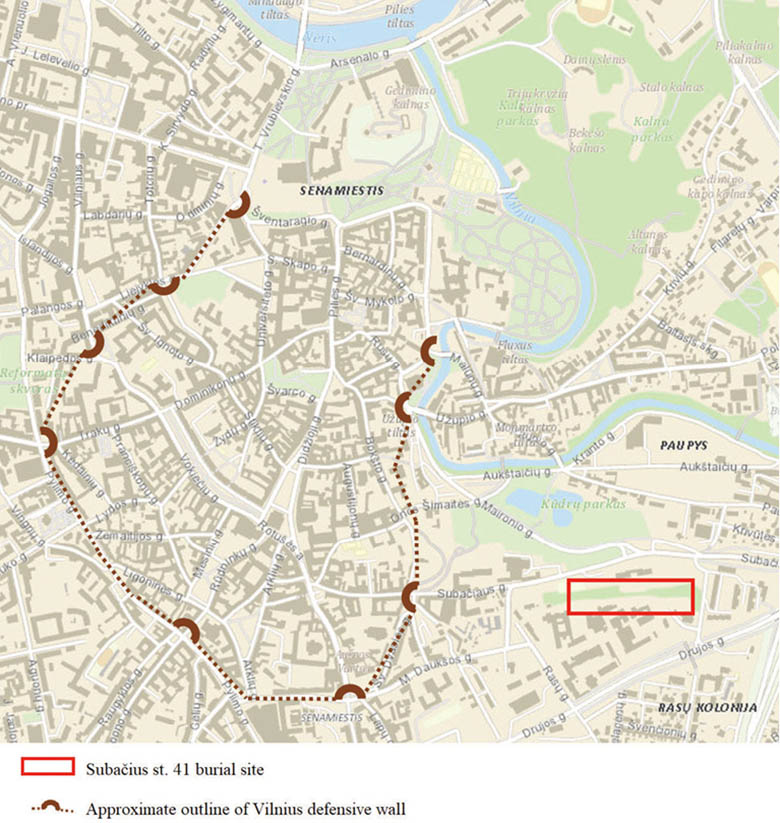
Fig. 1. Location map of Subačius Street 41 burial site and defensive wall of Vilnius in the 16th century.
1 pav. Vilniaus Subačiaus g. 41 senkapio vieta ir gynybinė Vilniaus siena XVI a.
Material and Methods
This study presents the human anthropological material that was uncovered in 2014 and 2015 (Stankevičiūtė, 2014; 2015). Before building a soccer pitch, a new playground, and a gym for The American International School of Vilnius, an archaeological excavation took place in the Subačius street 41 plot in Vilnius (Stankevičiūtė, 2014, p. 183). A total area of 284 m2 was excavated, and 126 graves were discovered in the East part of the plot in 2014. Some dead were interred in a chaotic manner with no signs of a clear order, orientated to the southwest, west, and north directions. Most individuals were single grave burials; however, eight graves (No. 4, 8, 9, 14, 52, 75, 78, 111) contained more than one individual.
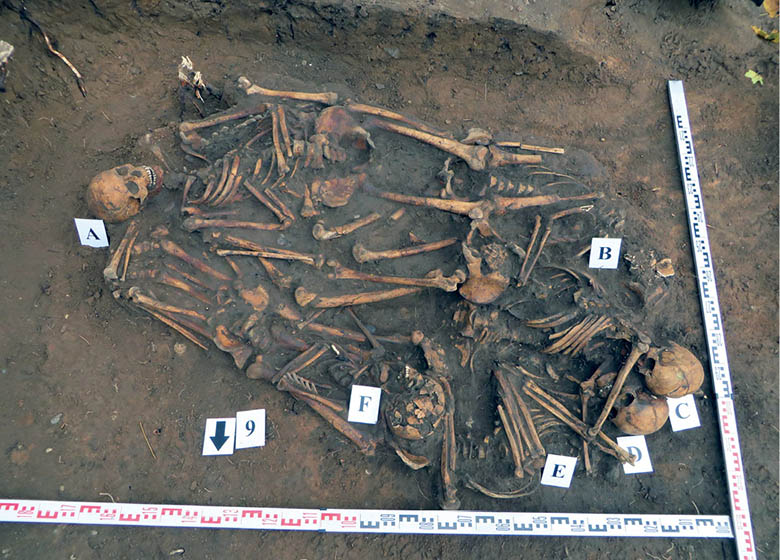
Fig. 2. Grave No. 9 with a minimum number of 6 individuals. Note the chaotic manner of the interred (disposed?) bodies. Photo courtesy Justina Stankevičiūtė.
2 pav. Mažiausiai šešių individų netvarkingas palaidojimas (užkasimas?) kape Nr. 9. Justinos Stankevičiūtės nuotrauka
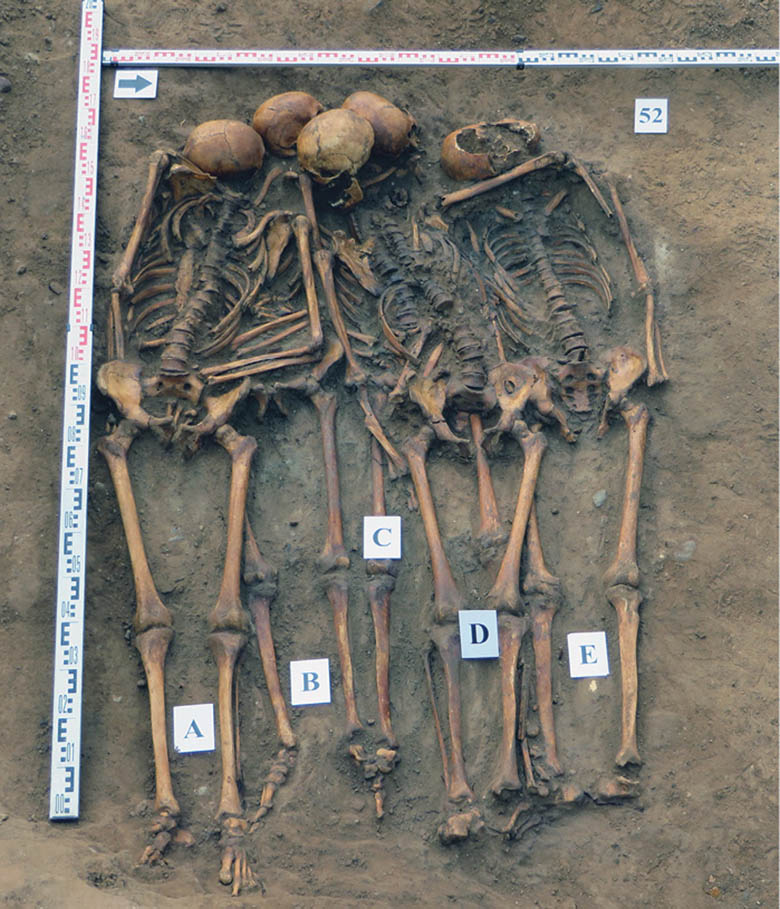
Fig. 3. Grave No. 52 with 5 individuals in one single pit. This mass grave is constituted of only adult males with at least two decapitation cases. Photo courtesy Justina Stankevičiūtė.
3 pav. Penki individai kape Nr. 52. Šiame masiniame kape užkasti tik vyrai, mažiausiai du iš jų buvo nukirstomis galvomis. Justinos Stankevičiūtės nuotrauka
The grave goods consisted almost of coins, while the preserved coffin nails suggested that the deceased were buried in wooden coffins (Stankevičiūtė, 2014). Meanwhile, in 2015, an additional area of 406.2 m2 was uncovered and 12 graves (no. 127–138) were found in the same E part of the plot (Stankevičiūtė, 2015). This burial site was dated to the second half of the 16th to 17th centuries. In total, 165 individuals were recorded in 138 graves.
A good preservation level of the anthropological material of these Subačius Street 41 individuals allowed to initiate visual examination of the human remains. Sex and age estimation, a paleopathological study, measurements, and a dental investigation were carried out by the authors based on the current methodology. Sex estimation was primarily based on sexually dimorphic traits of the pelvic bone and the skull (Buikstra and Ubelaker, 1994). Immature (under 18 years old) individuals were omitted from sex determination. Age at death for adults was estimated by changes in pubic symphysis (Brooks and Suchey, 1990), the auricular surface (Lovejoy et al., 1985), and sternal rib ends (Işcan and Loth, 1986a; 1986b). If none of these features were available for observation, the method of cranial suture obliteration was applied (Meindl and Lovejoy, 1985). In addition, a fusion of secondary ossification centres, such as the sternal end of clavicle, rib heads, sacral segments etc., was recorded for young adults (20–29 years) (Schaefer et al., 2009). Age estimation for non-adults was based on dental development and eruption, as recommended by Buikstra and Ubelaker (1994). In cases where the teeth were not present, the skeletal development of the juvenile skeleton was used (Schaefer et al., 2009).
Measurements of the maximum length of the femur were taken in order to reconstruct the stature for both sexes. If the left femur was fragmented, poorly preserved or absent, the right femur was measured – the differences between the left and right sides of the same bone are minimal and considered to be insignificant (Humprey, 2000). Stature was estimated using the regression formulas by Trotter and Gleser (1952).
To assess the pathological changes in each individual, data were collected for several indicators, such as non-specific stress markers, infectious diseases, metabolic conditions, trauma, and degenerative joint disease. The dental study included that of caries, tooth loss, periodontal disease, abscesses, calculus, tooth wear, and enamel hypoplasia. The brief summary of the applied methods is provided in Table 1. Fractures of the cranium are more often associated with inter-personal violence than those of any other skeletal element. Since most postcranial fractures are a result of daily activities, fracture frequencies are more likely to reflect lifestyle differences and not random events (Lovell, 1997); however, it is possible that some trauma could have been miscategorized. The frequency of each fracture was calculated for individuals by body region and by skeletal element. For population-level studies such as this, comparisons between the individuals comprising those populations, rather than between isolated skeletal elements are most appropriate (Kozakaitė, 2018b). Anatomical regions were only considered present for observation of trauma when at least 50% of the region was accounted for. For example, out of the five bones of the upper limb included here (clavicle, humerus, radius, ulna, wrist/hand), individuals with at least three different areas/elements represented were coded as “present” for the upper limb.
The prevalence rates of skeletal pathological conditions were calculated and presented as the number of cases and as percentages. Prevalence equals the number of affected individuals divided by the total number of individuals (151). Meanwhile, the prevalence rates of dental pathologies were calculated and presented as percentages of affected teeth.
Table 1. Recorded pathologies in this study.
1 lentelė. Šiame tyrime registruotos patologijos
|
Diagnostic criteria |
Bone affected |
Diagnosis |
Reference |
|
|
Non-specific stress marker |
Marrow hypertrophy in the diploë bone, also known as cribra orbitalia |
Orbital roofs |
A range of anaemias |
Walker, 2009 |
|
New (woven or lamellar) bone formation |
Diaphyses of long bones |
Cannot be attributed to a specific cause |
Weston, 2008; Klaus, 2014 |
|
|
Horizontal lines on the external surface of a tooth – linear enamel hypoplasia (LEH) |
Any tooth |
Cannot be attributed to a specific cause |
Hillson, 1996; Reid and Dean, 2006 |
|
|
A pitted defect on the external surface of a tooth – localized hypoplasia on primary canines (LHPC) |
Deciduous canines |
Cannot be attributed to a specific cause |
Lukacs et al., 2001 |
|
|
Metabolic disease |
Bowing, flattening, flaring, porosity |
Upper and lower limb bones, epiphyseal ends, cranial vault |
Rickets |
Ortner and Mays, 1998; Mays et al., 2006; Pinhasi et al., 2006; Brickley and Ives, 2008 |
|
Porosity and new bone formation |
Sphenoid bone, maxilla, scapula, orbital roofs |
Scurvy |
Brickley and Ives, 2008; Armelagos et al., 2014; Klaus, 2017; Snoddy et al. 2018 |
|
|
Specific infectious disease |
Bone destruction, abscess formation |
Vertebral bodies and joints, acetabulum, diaphyses |
Tuberculosis |
Roberts and Buikstra, 2003 |
|
New bone formation and destruction, caries sicca, sabre tibia, rhino-maxillary syndrome |
Frontal and parietal bones, maxilla, diaphyses of long bones |
Syphilis |
Hackett, 1975 |
|
|
Rhino-maxillary syndrome, bone resorption, pitting
|
Maxilla, nasal bones and septum, phalanges of hands and feet |
Leprosy |
Waldron, 2009 |
|
|
Trauma |
Clear, polished-edge cut, no signs of healing |
Any bone |
Perimortal fracture |
Lovell, 1997; Judd, 2002 |
|
Callus formation, thickening, lamellar and/or woven bone formation |
Any bone |
Antemortem fracture |
Lovell, 1997; Judd, 2002 |
|
|
Degenerative joint diseases (DJD) |
Multi-shaped impressions in the surfaces of the vertebral bodies, known as Schmorl’s nodes |
Superior and inferior surfaces of the vertebral body |
Disk herniation due to imposing great stress on the spine |
Waldron, 2009 |
|
Micro and macroporosity |
Superior and inferior surfaces of the vertebral body |
Osteochondrosis |
Kelley, 1982 |
|
|
New bone formation, porosity and/or eburnation |
Superior and inferior articular facets of the neural arch |
Spondilioarthrosis |
Waldron, 2009 |
|
|
New bone formation, porosity and/or eburnation |
Any articular surface of synovial joint |
Osteoarthritis |
Rodgers and Waldron, 1995 |
|
|
Bony irregular extensions that vary in shape and size |
Margins of the vertebral body |
Vertebral osteophytosis |
Ortner, 2003 |
|
|
Miscellaneous |
Any pathological bone changes |
Any bone |
Neoplastic and congenital diseases |
Aufderheide and Martin, 1998; Ortner, 2003 and others |
|
Dental disease |
Discoloration (brown spots) or disintegration of enamel or cementum leading to a cavity |
Any tooth |
Caries (dental decay) |
Hilson, 2001 |
|
Tooth loss, a socket partly or completely remodelled |
Alveolar part of maxilla and mandible |
Antemortem tooth loss (AMTL) |
Hilson, 1996 |
|
|
Tooth lost with no traces of socket remodelling |
Alveolar part of maxilla and mandible |
Postmortem tooth loss (PMTL) |
Hilson, 1996 |
|
|
Alveolar bone loss with associated pitted lesions on the bone surface |
Alveolar part of maxilla and mandible |
Periodontal disease |
DeWitte and Bekvalac, 2010 |
|
|
Cavity around tooth root with a perforating fistula |
Alveolar part of maxilla and mandible |
Abscess |
Brothwell, 1972 |
|
|
Mineralized deposits on a tooth crown or root |
Any tooth |
Calculus |
Brothwell, 1972 |
|
|
Attrition of occlusal surface of a tooth |
Any tooth |
Tooth wear |
Smith, 1984 |
Results
In total, the collected data present 151 individuals, including 83 adults and 68 non-adults. An overall good preservation and completeness level of the remains was observed. For example, the average percentage of skull elements per individual was up to 71%. The upper extremities preservation was 79.2%, while the lower 82.7%. The preservation level of the vertebral column varied among regions; the least to preserve were cervical vertebrae (57.7%), whereas the best-preserved vertebrae were from the lumbar region (71.8%). It is impossible to distinguish any differences between age groups or sexes; therefore it was considered, that neither age nor sex could somehow affect the overall results of preservation. Fourteen individuals were eliminated from this study due to poor preservation and commingled remains.
Sex determination was carried out for only mature individuals, presenting 50 (33.1%) males, 32 (21.2%) females and one individual of undetermined sex. The demographic distribution of the sample is provided in Table 2:
Table 2. The percentage of sex and age distribution in Subačius St. 41 sample.
2 lentelė. Lyties ir amžiaus procentinis pasiskirstymas Subačiaus g. 41 medžiagoje
|
0–4 |
5–9 |
10–14 |
15–19 |
18–20 |
20–29 |
30–39 |
40–49 |
50+ |
TOTAL |
|
|
Non-adults |
23.84% (36/151) |
7.95% (12/151) |
7.95% (12/151) |
5.30% (8/151) |
– |
– |
– |
– |
– |
45.03% (68/151) |
|
Males |
– |
– |
– |
– |
1.99% (3/151) |
7.95% (12/151) |
13.25% (20/151) |
6.62% (10/151) |
3.31% (5/151) |
33.11% (50/151) |
|
Females |
– |
– |
– |
– |
– |
3.97% (6/151) |
9.27% (14/151) |
4.64% (7/151) |
3.31% (5/151) |
21.19% (32/151) |
|
Unidentified |
– |
– |
– |
– |
– |
0.66% (1/151) |
– |
– |
– |
0.66% (1/151) |
In the non-adult group, neonates and infants I (0–4 years old) demonstrated the highest percentage of death rate in the population (24%), whereas the number of infants II (between 5 and 14 years) was three times lower (8%). The lowest number of individuals, with only three subjects represented (2%), were in the 18–20 age group. Meanwhile, the highest number of females and males were in the 30–39 age group. The distribution of adultus (20–29 years), maturus (40–49 years) and senilis (over 50 years) adults was similar for both sexes. The demographic profile can be supplemented by a general life table, which is used to measure mortality, survivorship, and life expectancy of a population at varying ages (Chamberlain, 2006). It shows that approximately, an individual born in this population would have had a chance of survival until ~24 years (Table 3).
Table 3. Life table of Subačius st. 41 population.
3 lentelė. Subačiaus g. 41 populiacijos gyvenimo lentelė
|
Age |
Dx* |
dx |
lx |
qx |
Lx |
Tx |
ex |
|
0 |
19 |
0.13 |
1.00 |
0.13 |
0.94 |
23.82 |
23.82 |
|
1-4 |
17 |
0.11 |
0.87 |
0.13 |
4.09 |
22.88 |
26.17 |
|
5-9 |
12 |
0.08 |
0.76 |
0.10 |
3.61 |
18.79 |
24.67 |
|
10-14 |
12 |
0.08 |
0.68 |
0.12 |
3.21 |
15.18 |
22.26 |
|
15-19 |
11 |
0.07 |
0.60 |
0.12 |
2.83 |
11.97 |
19.86 |
|
20-29 |
19 |
0.13 |
0.53 |
0.24 |
4.67 |
9.14 |
17.25 |
|
30-39 |
34 |
0.23 |
0.40 |
0.56 |
2.91 |
4.47 |
11.07 |
|
40-49 |
17 |
0.11 |
0.18 |
0.63 |
1.23 |
1.56 |
8.70 |
|
50+ |
10 |
0.07 |
0.07 |
1.00 |
0.33 |
0.33 |
5.00 |
|
Total |
151.00 |
1.00 |
|
|
23.82 |
|
|
* Dx – number of individuals per age group; dx – the number of deaths between exact ages x and x+1; lx – the number of persons surviving to exact age x; qx – the probability that a person exact age x will die within one year; Lx – the number of person-years lived between exact ages x and x+1; Tx – the number of person-years lived after exact age x; ex – the average number of years of life remaining at exact age x.
The average male stature was calculated to be 168.2 cm ± 3.4 cm (median 168.3 cm) based on 35 individuals (Fig. 4). The highest value of stature was of an individual from grave No. 52A, namely 180.9 cm; though all five individuals from grave No. 52 were above (178.5 cm) the population average. Moreover, this mass grave contained three individuals with perimortal marks of decapitation (individuals 52A, 52B and 52C) (Kozakaitė et al., 2018). The shortest male individual was found in grave No. 117 (18–20 yrs) – 155.7 cm. When massive burials were eliminated from the sample, the average height decreased to 166.5 cm in the male group. On average, female stature was 157.8 cm ± 5.2 cm (median 157.3 cm), based on only 25 individuals. The tallest female individual was 168 cm, while the shortest only 147 cm.
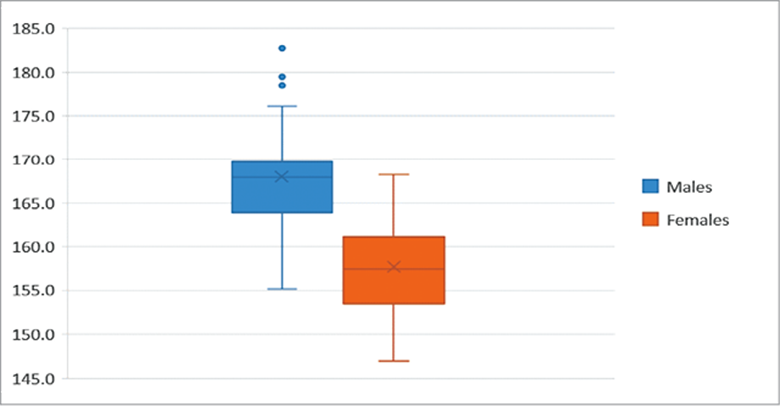
Fig. 4. Boxplot comparing the average height between both sexes. Whiskers define the highest and shortest individuals. Meanwhile, dots represent the outliers or more than 3/2 times of the upper quartile.
4 pav. Tirtos populiacijos vyrų ir moterų vidutinio ūgio palyginimas. „Ūsai“ rodo didžiausias ir mažiausias ūgio reikšmes. Taškai žymi išskirtis, esančias už stačiakampės diagramos dėžutės atstumu, didesniu nei 1,5 tarpkvartilinio intervalo
The results of the paleopathological examination are presented for non-adults and adults in Fig. 5. Crude prevalence rates (CPR) of pathology in non-adults (in %).
5 pav. Patologijų pasiskirstymas (%) nesuaugusiųjų grupėje. and Fig. 7, respectively. A total of 113 individuals (74.8% of the total sample) had at least one pathological condition. Non-adults demonstrated more pathological cases than adults – in total 48 cases (42.5% of total pathological cases), including non-specific stress markers and metabolic bone disorders (Fig. 5).
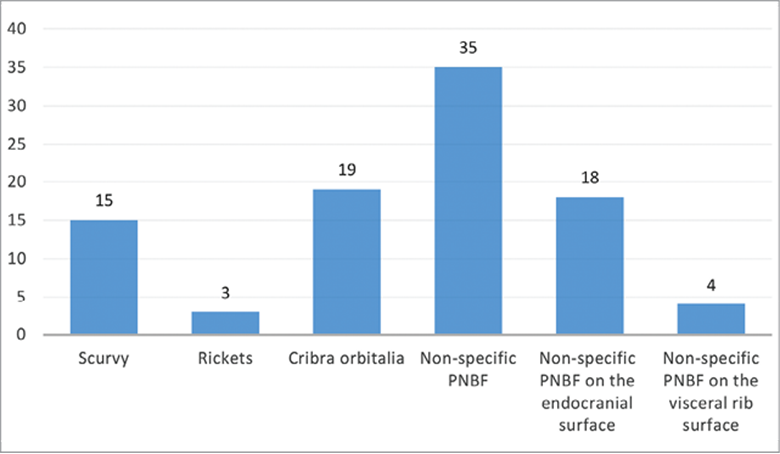
Fig. 5. Crude prevalence rates (CPR) of pathology in non-adults (in %).
5 pav. Patologijų pasiskirstymas (%) nesuaugusiųjų grupėje.
Within non-adults, the highest prevalence rate was the PNBF (24 cases or 35%). The rates of scurvy (10 cases or 15%), cribra orbitalia (13 cases or 19%) and PNBF on the endocranial surface (12 cases or 18%) were also exceptionally high. The lowest rates, counting for only 3%–4% (2 and 3 cases respectively), in the non-adult group were for rickets (Fig. 6. Grave No. 92, non-adult, 2–4 years old. A case of rickets. Note the slight bowing of both tibiae. Photo courtesy Rūta Brindzaitė.
6 pav. Kapas Nr. 92, nesuaugęs individas, 2–4 metų. Rachito atvejis, kuriam būdingas abiejų blauzdikaulių išlinkimas. Rūtos Brindzaitės nuotrauka) and non-specific PNBF on the visceral rib surfaces. Overall, the prevalence of pathology was high in all non-adult age groups, with more than one condition recurring in a non-adult individual.
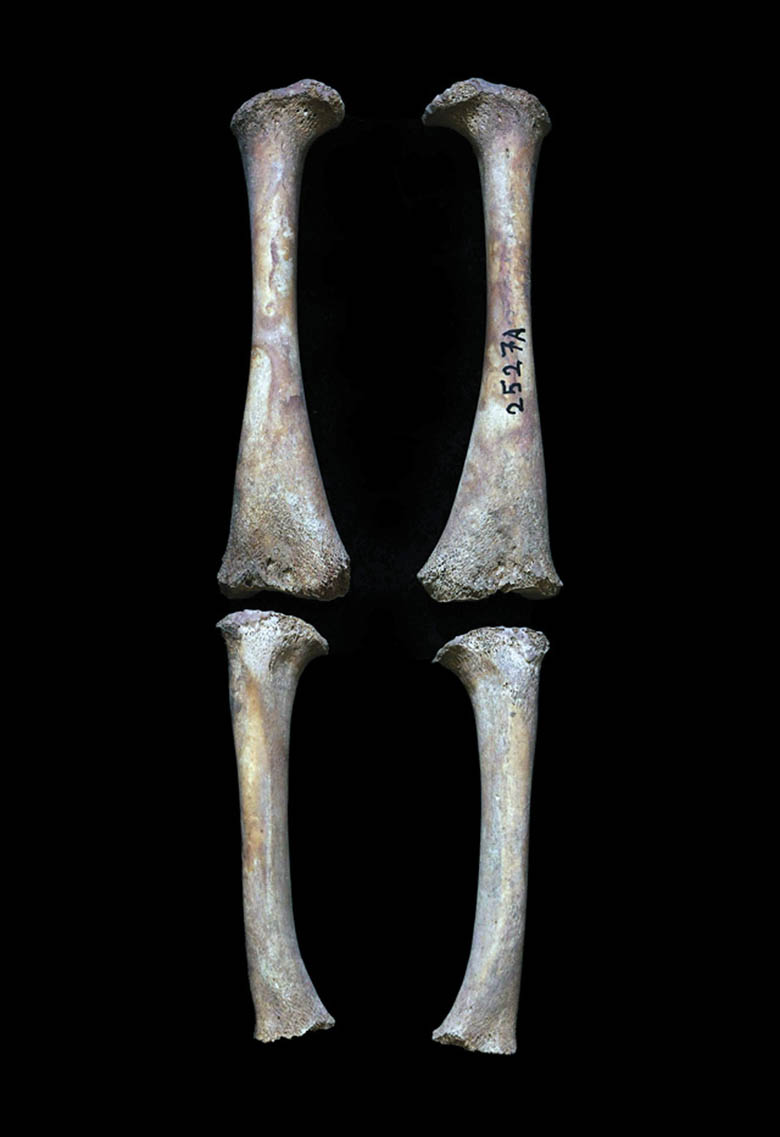
Fig. 6. Grave No. 92, non-adult, 2–4 years old. A case of rickets. Note the slight bowing of both tibiae. Photo courtesy Rūta Brindzaitė.
6 pav. Kapas Nr. 92, nesuaugęs individas, 2–4 metų. Rachito atvejis, kuriam būdingas abiejų blauzdikaulių išlinkimas. Rūtos Brindzaitės nuotrauka
As well as for non-adults, PNBF had the highest rate in the adult group (21 cases or 25%), mostly affecting the tibia, though the rates of osteitis and osteomyelitis accounted only 1%–4% of all cases. The rate of cribra orbitalia in the adult sample was low (only 9 cases or 11%), but recorded in both males and females (Fig. 7). Three cases of tuberculosis (4%) were also diagnosed. No cases of syphilis or leprosy were observed in the Subačius Street 41 material.
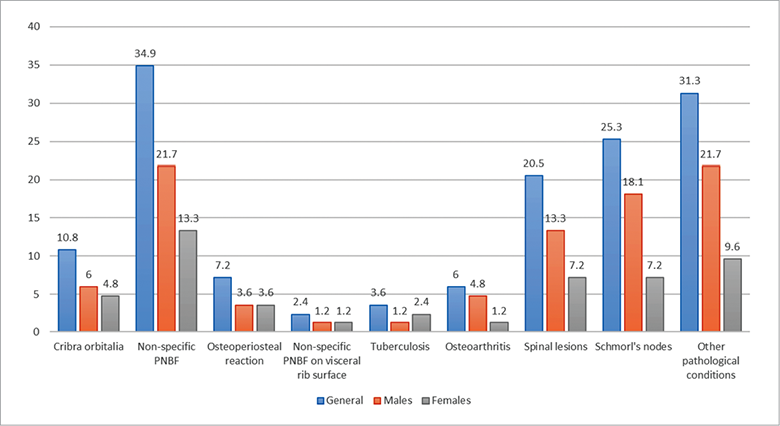
Fig. 7. Crude prevalence rates (CPR) of pathology in adults.
7 pav. Patologijų pasiskirstymas (%) suaugusiųjų grupėje
Although degenerative joint diseases (DJD) are generally accepted as a pathological condition of multifactorial aetiology (Weiss and Jurmain, 2007), most regard it specifically as an age-related phenomenon, which is the result of continuous mechanical loading of the joints or spine throughout the lifetime of an individual (Rogers and Waldron, 1995; Larsen, 2015). Findings from Subačius Street 41 indicated that age was a significant aetiological factor of DJD prevalence for both males and females. Males were afflicted by the disease more than females in the knees (osteoarthritis) and spine (osteochondrosis and spondilioarthrosis) (7 females and 12 males). Males also suffered from Schmorl’s nodes – out of 21 cases, 15 were in the male group. Schmorl’s nodes are formed when damage to the vertebral endplate compresses the intervertebral disk, the anulus fibrosus is weakened, and the nucleus pulposus protrudes through the fibrous capsule.
Traumatic injuries were divided into three major groups: non-accidental (or violent), accidental (or occupational), and unknown. To identify a fracture as the result of violent behaviour, different causes were evaluated, including falls, which are the most frequent cause in living populations; therefore, careful observations of bones that are associated with violence were needed, such as facial bones, ribs, hands, scapulae, and the sternum. In total, 40 individuals (26.5%) had fractures: 20 individuals (13.25%) had multiple fractures, whilst the other half (13.25%) experienced traumatic injury only once. In all cases, the number of males, or in total 30 males, and their sustained fractures number, or 56 fractures out of a total 70 fractures, outnumbered females, i.e., 10 females with 14 fractures. Twenty-nine cases (19.2%) could be attributed to accidental injuries, as both sexes experienced long bone lesions of the upper and lower extremities. However, several cases, especially associated with high-energy traumatic injuries, were hard to attribute to either the accidental or non-accidental category (Fig. 8. Grave No. 83, male, 40–45. The fracture of ramus inferior and ramus superior with no signs of initial healing – pseudarthritis formation is present. Note the deformation level of the corpus of pubis. Photo courtesy Rūta Brindzaitė.). Fourteen (9.27%) individuals suffered violent injuries, including nasal bone or skull fractures. In total, 3 females and 11 males were subjected to violent encounters. At least 6 cases were perimortal: three adult males between 20–40 showed evidence of cut signs in the cervical region, which suggest cases of decapitation (see Kozakaitė et al., 2018); a male over 50 yearsold suffered a spiral perimortal femur fracture (Fig. 9. Grave No. 72, male over 50. A perimortal fracture of the left femur. No signs of healing were recorded. Photo courtesy Rūta Brindzaitė.); a young 20–29 male displayed a sharp force injury to the back of his head with no signs of healing (Fig. 10); and a young 20–29 male demonstrated a perimortal ulna fracture.
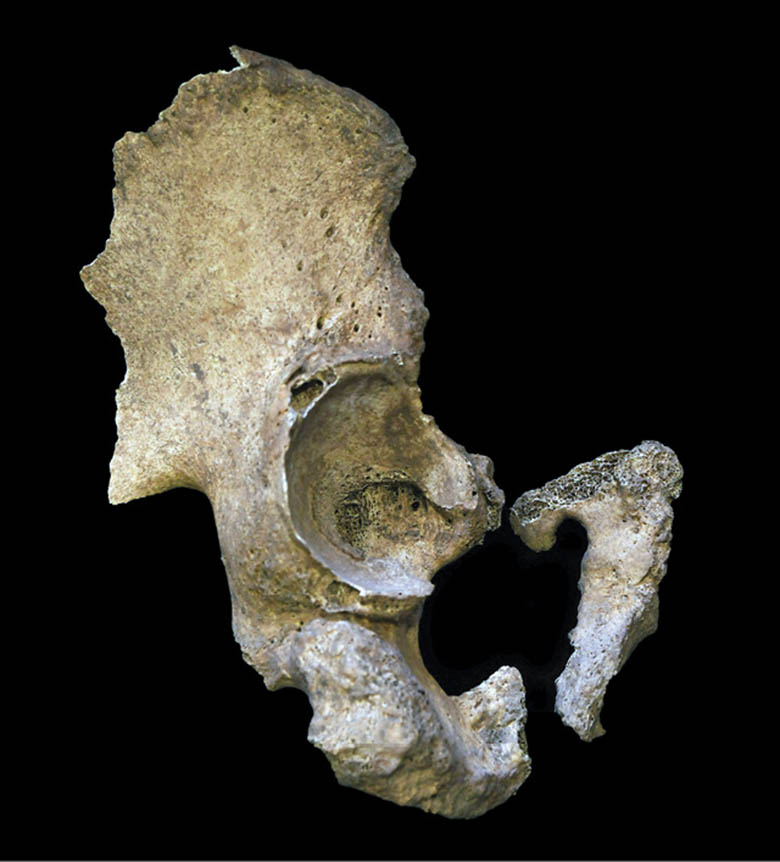
Fig. 8. Grave No. 83, male, 40–45. The fracture of ramus inferior and ramus superior with no signs of initial healing – pseudarthritis formation is present. Note the deformation level of the corpus of pubis. Photo courtesy Rūta Brindzaitė.
8 pav. Kapas Nr. 83, vyras, 40–45 metų. Gaktikaulio viršutinės ir apatinės šakų lūžiai ir susiformavęs pseudoartritas su ryškia gaktikaulio kūno deformacija. Rūtos Brindzaitės nuotrauka
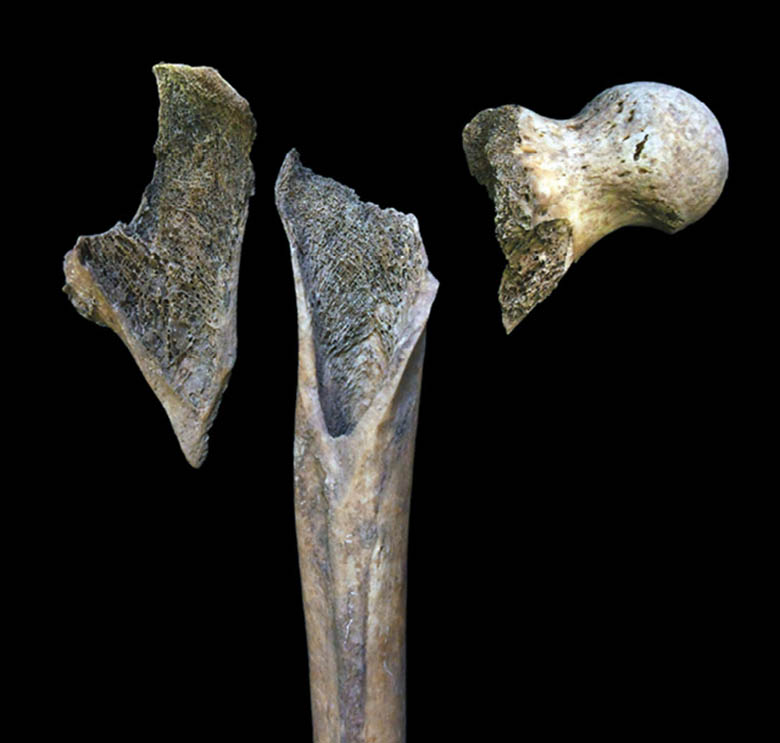
Fig. 9. Grave No. 72, male over 50. A perimortal fracture of the left femur. No signs of healing were recorded. Photo courtesy Rūta Brindzaitė.
9 pav. Kapas Nr. 72, vyras, >50 metų. Perimortalinis kairiojo šlaunikaulio lūžis be gijimo žymių. Rūtos Brindzaitės nuotrauka
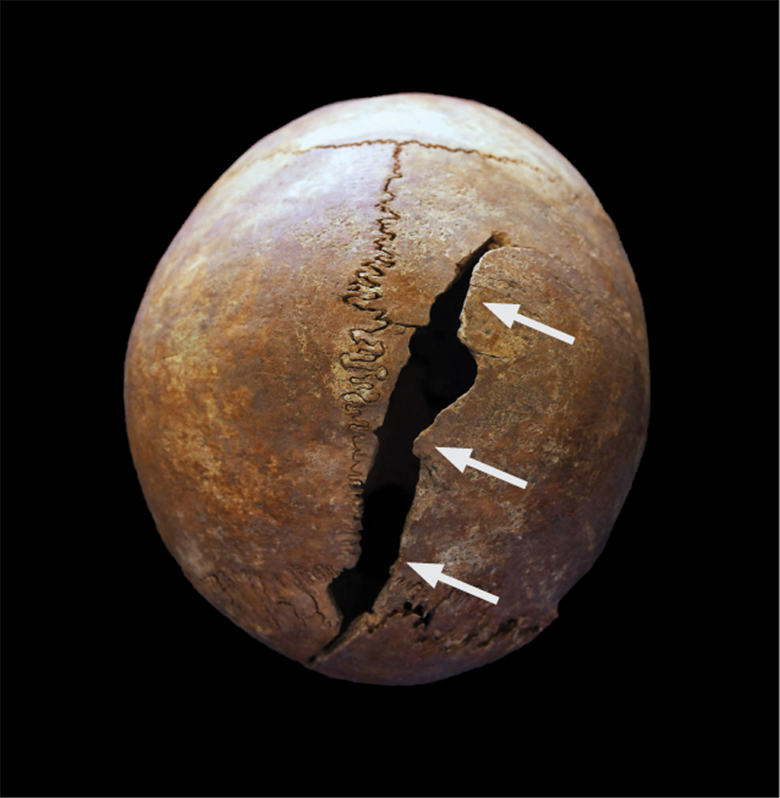
Fig. 10. Grave No. 90, male, 20–29. Sharp force perimortal trauma to the back of the head of a young male. Photo courtesy Rūta Brindzaitė.
10 pav. Kapas Nr. 90, vyras, 20–29 metų. Aštriu įrankiu sukeltas mirtinas pakaušio srities sužalojimas. Rūtos Brindzaitės nuotrauka
Several pathological conditions could not be assorted into any major pathological conditions classifications; thus, they fell into the “miscellaneous” group. Conditions like a possible case of rheumatoid arthritis (grave No. 85; male, 45–50), DISH (grave No. 32: male, 45–50), or even a tumor of the forehead (grave No. 24; male, 30–39) were observed. The latter case (Fig. 11. Grave No. 24, male, 30–39. Lytic lesion on the right side of the frontal bone. A possible case of tumor. Photo courtesy Rūta Brindzaitė.
11 pav. Kapas Nr. 24, vyras, 30–39 metų. Ardomasis pažeidimas dešinėje kaktikaulio pusėje. Įtariamas naviko atvejis. Rūtos Brindzaitės nuotrauka) is of special interest for detailed future studies, as malignant tumors are rare, because evidence of oncological disorders deduced from the past literature and documental records is scarce; thus, palaeopathological studies of past populations may uncover new details about prevalence of these cases and answer some crucial questions on the morbidity and mortality from malignant neoplasms (Marques, 2018).
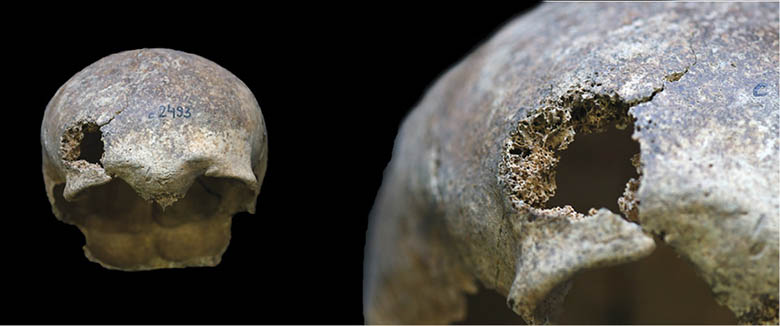
Fig. 11. Grave No. 24, male, 30–39. Lytic lesion on the right side of the frontal bone. A possible case of tumor. Photo courtesy Rūta Brindzaitė.
11 pav. Kapas Nr. 24, vyras, 30–39 metų. Ardomasis pažeidimas dešinėje kaktikaulio pusėje. Įtariamas naviko atvejis. Rūtos Brindzaitės nuotrauka
Dental analysis was carried out on 121 individuals (2285 teeth) in total. Five age categories were defined based on the eruption of teeth (Table 4). Results were presented for each age-at-death category. As primary analysis revealed no substantial differences between the dental status of males and females emerged; thus, the results of both sexes for adult individuals were pooled.
Table 4. Five age categories and a number of individuals representing each category.
4 lentelė. Penkios amžiaus kategorijos ir individų skaičius, reprezentuojantis kiekvieną šių kategorijų
|
Stages |
Age-at-death |
Representation |
No. of non-adults |
|
Young children (YO) |
1–6 |
Deciduous dentition |
18 (14.9%) |
|
Older children (OC) |
7–12 |
Mixed dentition |
9 (7.4%) |
|
Adolescents (Ad) |
13–20 |
Permanent dentition, yet skeletal maturation is incomplete |
14 (11.6%) |
|
Young adults (YA) |
21–40 |
Permanent dentition |
49 (40.5%) |
|
Mature/old individuals (MOA) |
41+ |
Permanent dentition |
22 (18.2%) |
An analysis of caries revealed that 56% of non-adults and more than 80% of adults had at least one tooth affected. The average number of decayed teeth per individual ranged from 1.4 among children up to 5.3 in mature adults. Percentages of teeth with caries in each age of death group are presented in Table 5.
Table 5. Prevalence of dental pathologies by teeth in different age groups.
5 lentelė. Dantų patologijų pasiskirstymas tarp skirtingų amžiaus grupių
|
Age group |
YC |
OL |
Ad |
YA |
MOA |
Total adults |
||||||
|
n/N |
% |
n/N |
% |
n/N |
% |
n/N |
% |
n/N |
% |
n/N |
% |
|
|
Caries |
29/213a |
13.6 |
13/118 |
11.0 |
17/355 |
4.8 |
232/1204 |
19.3 |
116/395 |
29.4 |
348/1599 |
21.8 |
|
AMTL |
0/333b |
0 |
0/176 |
0 |
0/426 |
0 |
46/1428 |
3.2 |
154/655 |
23.5 |
200/2083 |
9.6 |
|
Abscesses |
0/333b |
0 |
0/176 |
0 |
0/426 |
0 |
43/1428 |
3.2 |
53/655 |
10.7 |
96/2083 |
5.2 |
|
Periodontal disease |
0/213a |
0 |
0/118 |
0 |
0/352 |
0 |
380/1160 |
32.8 |
242/360 |
67.2 |
622/1520 |
40.9 |
|
Calculus1 |
3/213a 0/213a |
1.4 0 |
32/118 7/118 |
27.1 5.9 |
91/355 3/355 |
25.8 0.8 |
757/1204 163/1204 |
63.6 13.7 |
298/395 80/395 |
78.4 21.1 |
1055/1599 243/1599 |
67.2 15.5 |
Young children (YC), older children (OC), adolescents (Ad), young adults (YA), middle and old adults (MOA).
1 total prevalence of teeth with calculus, and prevalence of teeth with moderate and severe defects.
a number of teeth with particular defect out of total number of teeth available.
b number of teeth sockets with a particular defect out of total number of teeth sockets available.
Among YC, 89% of the lesions were of initial or shallow degrees, while moderate caries prevailed among OC. The severity of caries of permanent teeth increased with age: 94% of decay in adolescent’s dentition were at the stage of the beginning, while 42.2% of affected teeth in YA and 48.3% of affected teeth in MOA had moderate and severe lesions. In all age-at-death groups occlusal surface was among the most frequently affected. An analysis of the dentition of non-adults revealed no substantial changes in the location of cavities with age. However, an analysis of decayed teeth of adult individuals revealed a significant increase in approximal (both coronal and root) and gross caries in the MOA group. Severity and the location of caries in each age of death group is presented in Table 6.
An analysis of tooth loss revealed a low prevalence of AMTL among young adults: 40% of individuals had at least on tooth loss before death, yet only 3.2% of the teeth were lost in total (0.9 of teeth per individual on the average). In the MOA group, 83% of individuals had AMTL, and the number of antemortem lost teeth increased to 23.5% (7.0 of teeth per individual on the average). No cases of antemortem lost teeth were found in children and adolescent groups. The percentage of lost teeth in each age of death group are presented in Table 5.
Table 6. Severity and location of caries in different age groups.
6 lentelė. Ėduonies pažeidimų stiprumas ir lokalizacija skirtingose amžiaus grupėse
|
Age group |
YC |
OL |
Ad |
YA |
MOA |
Total |
||||||
|
n/N |
% |
n/N |
% |
n/N |
% |
n/N |
% |
n/N |
% |
n/N |
% |
|
|
Severity of caries1 |
||||||||||||
|
Initial |
15/29 |
51.7 |
2/24 |
8.3 |
9/17 |
52.9 |
76/232 |
32.8 |
34/116 |
29.3 |
110/346 |
31.8 |
|
Shallow |
11/29 |
37.9 |
3/24 |
12.5 |
7/17 |
41.2 |
58/232 |
25.0 |
26/116 |
22.4 |
83/346 |
24.0 |
|
Moderate |
2/29 |
6.9 |
10/24 |
41.7 |
1/17 |
5.9 |
62/232 |
26.7 |
31/116 |
26.7 |
94/346 |
27.2 |
|
Severe |
1/29 |
3.4 |
0/24 |
0 |
0/17 |
0 |
36/232 |
15.5 |
25/116 |
21.6 |
59/346 |
17.1 |
|
Location of carious cavities2 |
||||||||||||
|
Occlusal |
11/90 |
12.2 |
8/70 |
11.4 |
10/199 |
5.0 |
60/540 |
11.1 |
17/144 |
11.8 |
77/882 |
8.7 |
|
Coronal approximal |
14/426 |
3.3 |
5/236 |
2.1 |
5/710 |
0.7 |
86/2408 |
3.6 |
52/790 |
6.6 |
138/3198 |
4.3 |
|
Root approximal |
0/426 |
0 |
5/236 |
2.1 |
0/710 |
0 |
54/2408 |
2.2 |
39/790 |
4.9 |
93/3198 |
2.9 |
|
Root bucal |
2/213 |
0.9 |
0/118 |
0 |
0/355 |
0 |
30/1204 |
2.5 |
11/395 |
2.8 |
41/1599 |
2.6 |
|
Gross |
0/213 |
0 |
0/118 |
0 |
0/355 |
0 |
32/1204 |
2.7 |
19/395 |
4.8 |
51/1599 |
3.2 |
Young children (YC), older children (OC), adolescents (Ad), young adults (YA), middle and old adults (MOA).
1 number of teeth with particular type of lesion out of total number of teeth with caries; severity of caries was defined according to following criteria: initial – a brown spot with slightly polished enamel, shallow – a cavity that penetrates enamel or outer half of the dentin, moderate – a cavity with inner half of dentine affected, and severe – a cavity with exposed dental pulp.
2 number of particular tooth surfaces affected out of total number of surfaces at risk; in case of extensive decay, where there was no possibility to determine the initial surface, caries was defined as gross.
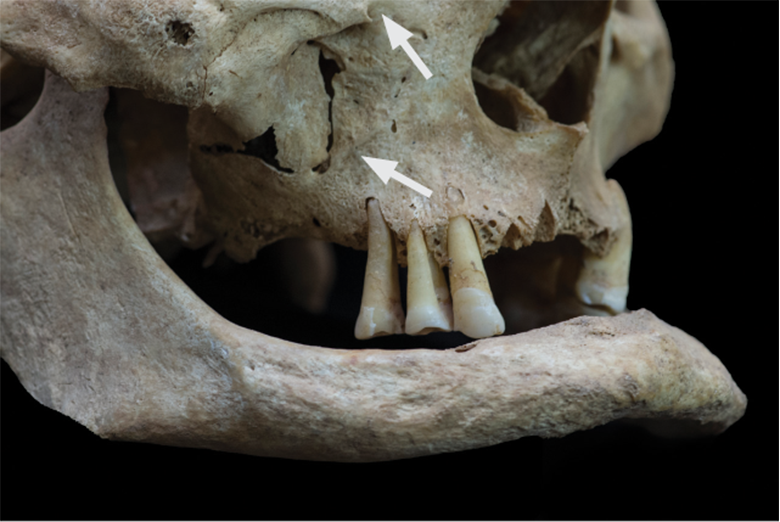
Fig. 12. Grave No. 30, male over 50. Heavy antemortem tooth loss. Note healed fracture of the right side of the maxilla. Photo courtesy Justina Kozakaitė.
12 pav. Kapas Nr. 30, vyras, >50 metų. Visų dantų priešmirtinis netekimas. Dešinės pusės viršutinio žandikaulio sugijęs lūžis. Justinos Kozakaitės nuotrauka
An investigation of periodontal disease revealed no marked alveolar bone loss in non-adult and adolescent dentition. However, more than 80% of adults had evidence of moderate to severe alveolar bone loss (in total, 40.9% of teeth were affected by periodontal disease). Periapical abscesses were detected only in the adult dentition, in total, 55% of the individuals and 5.2% of teeth were affected. The percentage of teeth with periodontal disease and abscesses in each age of death group are given in Table 5.
The majority of deciduous teeth of non-adults had no traces of calculus or only slight deposits. Only one individual in the OC group had moderate dental stones. Slight calculus deposits also prevailed among adult individuals. The severity of calculus increased only in the MOA age group, where 21% of the teeth were covered by moderate and severe dental tartar (Fig. 13). The percentage of total number of teeth with calculus in each age of death group are presented in Table 5.

Fig. 13. Grave No. 20, male, 35–40. Calculus formation on the right side, while the left side was not affected. Photo courtesy Justina Kozakaitė.
13 pav. Kapas Nr. 20, vyras, 35–40 metų. Dantų akmenų sankaupos dešinėje pusėje, kairė pusė – nepažeista. Justinos Kozakaitės nuotrauka
A dental wear analysis revealed a moderate tooth wear with a pattern of attrition typical for the time period under study. The average degree of dental attrition increased gradually with age in all teeth categories, indicating equal masticatory tooth wear (Fig. 14. The average degree of permanent tooth wear in adolescents (Ad) and young adults (YA) and middle and old adults (MOA). Tooth type: I – incisors, C – canines, P – premolars, M – molars.
14 pav. Vidutinis nuolatinių dantų nusidėvėjimo laipsnis paauglių (Ad), jaunų suaugusiųjų (YA) ir vidutinio bei vyresnio amžiaus suaugusiųjų (MOA) amžiaus grupėse. Dantų tipai: I – kandžiai, C – iltiniai, P – kapliai, M – krūminiai dantys and Fig. 15. The average degree of deciduous tooth wear in young children (YC) and older children (OC). Tooth type: I – incisors, C – canines, P – premolars, M – molars.
15 pav. Vidutinis pieninių dantų nusidėvėjimo laipsnis mažų vaikų (YC) ir vyresnių vaikų (OC) amžiaus grupėse. Dantų tipai: I – kandžiai, C – iltiniai, P – kapliai, M – krūminiai dantys).
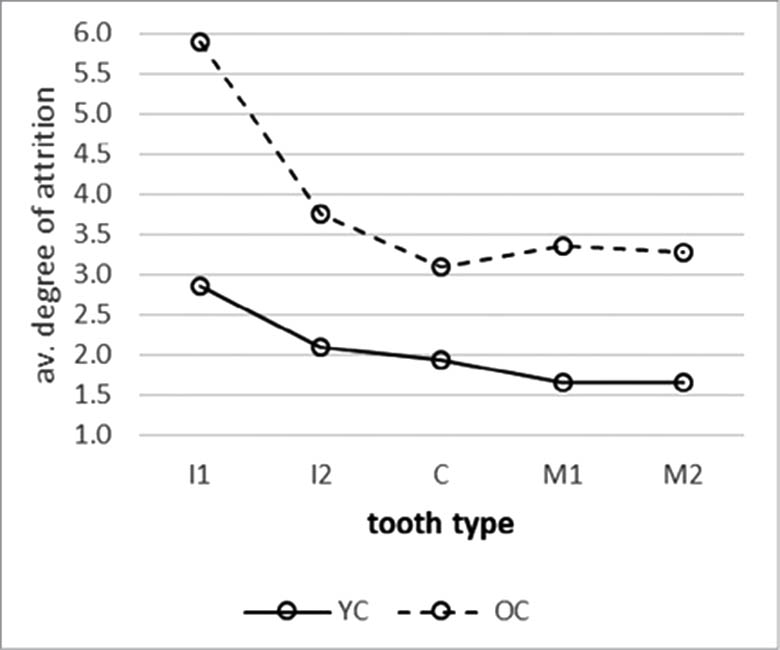
Fig. 14. The average degree of permanent tooth wear in adolescents (Ad) and young adults (YA) and middle and old adults (MOA). Tooth type: I – incisors, C – canines, P – premolars, M – molars.
14 pav. Vidutinis nuolatinių dantų nusidėvėjimo laipsnis paauglių (Ad), jaunų suaugusiųjų (YA) ir vidutinio bei vyresnio amžiaus suaugusiųjų (MOA) amžiaus grupėse. Dantų tipai: I – kandžiai, C – iltiniai, P – kapliai, M – krūminiai dantys
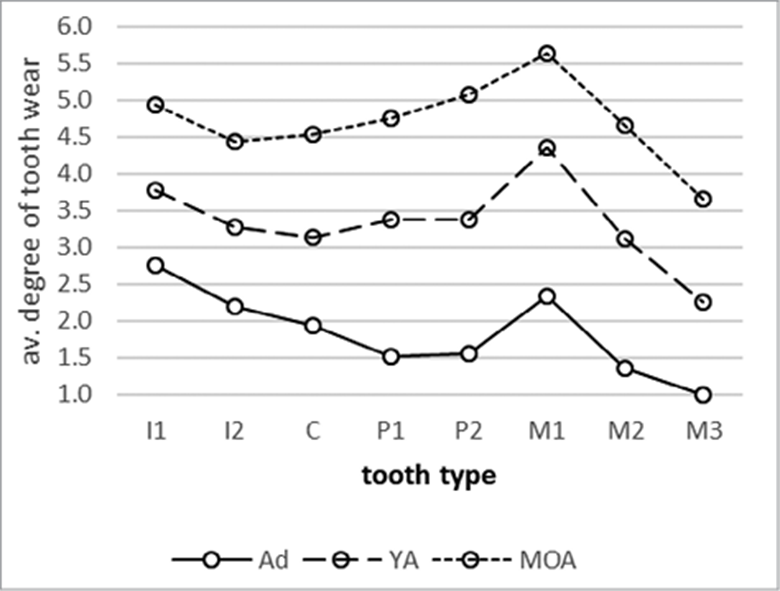
Fig. 15. The average degree of deciduous tooth wear in young children (YC) and older children (OC). Tooth type: I – incisors, C – canines, P – premolars, M – molars.
15 pav. Vidutinis pieninių dantų nusidėvėjimo laipsnis mažų vaikų (YC) ir vyresnių vaikų (OC) amžiaus grupėse. Dantų tipai: I – kandžiai, C – iltiniai, P – kapliai, M – krūminiai dantys
A total of 75 individuals with permanent teeth and 25 individuals with deciduous teeth were scored for the presence or absence of dental enamel defects. The analysis revealed that 77.3% of individuals with permanent teeth showed linear enamel hypoplasia, indicating systemic unspecific stress episodes experienced in childhood; 67.2% of individuals with LEH had moderate to severe defects (Fig. 16. Grave No. 89, male, 30–35. Enamel hypoplasia visible on the front teeth. Photo courtesy Justina Kozakaitė.
16 pav. Kapas Nr. 89, vyras, 30–35 metų. Priekinių dantų emalio hipoplazijos. Justinos Kozakaitės nuotrauka). The majority of stress episodes were experienced in the period from 2 to 4 years of age. No LEH was found on the deciduous dentition; however, the teeth of 10 children (40%) had localized hypoplasia on their primary canines, indicating unspecific stress episodes experienced in utero or during the first year of life.
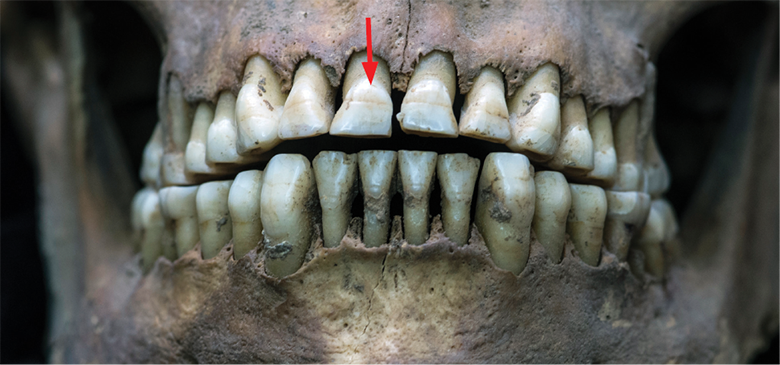
Fig. 16. Grave No. 89, male, 30–35. Enamel hypoplasia visible on the front teeth. Photo courtesy Justina Kozakaitė.
16 pav. Kapas Nr. 89, vyras, 30–35 metų. Priekinių dantų emalio hipoplazijos. Justinos Kozakaitės nuotrauka
The Outcasts of Vilnius? Discussion, Problems and Conclusion
To date, anthropological comparative studies from Lithuania are rare. Only several studies published previously can draw an overall picture of the past populations and the environment that affected their general well-being (Vėlius, 2005; Jankauskas, 2005; Jankauskas, 2009). Unfortunately, the majority of all studies are mostly pre-written and historically biased (Balčiūnienė et al., 1992; Jankauskas, 1993; Jankauskas and Urbanavičius, 1997; Antanaitis-Jacobs et al., 2002; Jankauskas, 2012; etc.); hence, the results from historical periods are scarce and usually oriented toward a specific pathological condition or lesion (Jankauskas, 1989; Jankauskas, 1991; Jankauskas, 1992; Jankauskas, 1995; Palubeckaitė et al., 2002; Kozakaitė and Jankauskas, 2013; etc.). Though Vilnius is excavated more often than any other city or region in Lithuania, the overall bioarchaeological comparative studies are still relatively scarce. Hence, our knowledge of its dwellers, their lifestyle, and everyday struggles is still an untapped territory, begging for scrutinized research. As previously noted, Subačius Street 41 attracted the researchers’ attention with its unique context, or mainly the lack of it, followed by mass and single burials (Fig. 17), and some intriguing preliminary anthropological results. Deceased who were buried outside the city, unrecorded, with numerous pathological conditions depicting most possibly harsh living conditions. Obviously, some questions needed to be answered: who are these people buried outside the city walls of Vilnius? And is it possible for a bioarchaeological approach of a certain population, in this case that of Subačius Street 41, to draw an overall picture of the Vilnius citizens? Generally, the individuals buried in this cemetery were treated according to the normative burial practices of that time period; following Christian beliefs, the dead were buried supine, stretched out, in a SW, W or NW orientation (Stankevičiūtė, 2014; 2015), and without grave goods in cemeteries associated with parish churches. Yet some individuals were buried in groups, suggesting simultaneous burial during a period of increased mortality, like war, epidemics, famine, etc. May anthropological data answer or at least provide a little glimpse into the status of these individuals?
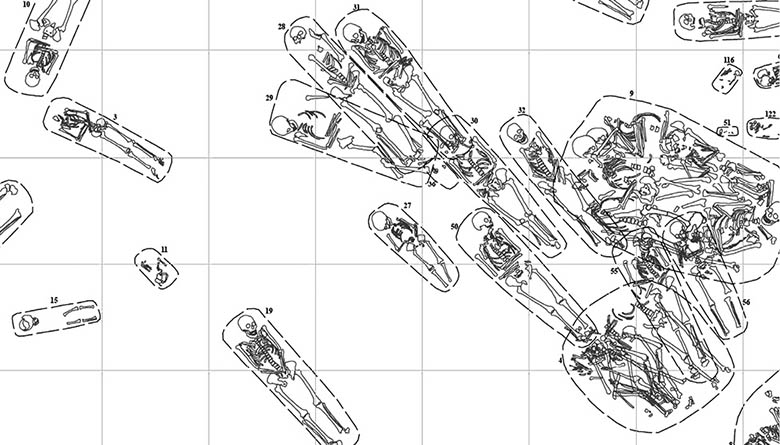
Fig. 17. An extract from spatial layout of graves in Subačius st. 41 site. Adapted from Stankevičiūtė (2015).
17 pav. Subačiaus g. 41 kapų erdvinio išdėstymo plano fragmentas. Remiantis Justinos Stankevičiūtės ataskaita (2015)
The demographic profile of Subačius Street 41 would represent natural mortality; infant mortality was high, constituting 45% of the whole population; even if the individuals had survived childhood, the age expectancy was approximately 24 years. These numbers are fairly low, yet not so uncommon for the period; e.g., in the 13th–17th c. Latvia, the average life expectancy for a newborn was ~25 years (Rudovica et al., 2009). This trend is visible all over Europe (Steane, 1985).
The paleopathological findings of Subačius Street 41 suggest that the living conditions in an urban environment might be slightly different than those of other contemporaneous populations. Results suggest that inhabitants of an unknown cemetery in Vilnius experienced periodic stress and rigorous living conditions with numerous cases of non-specific stress markers, like non-specific periosteal bone reactions (42.1% of total population), cribra orbitalia (10.8%), or enamel hypoplasia (77.3%). The common occurrence of trauma (26.5%) and various spinal diseases and lesions (45.8%) all point to a number of stressors in the lives of the people in Vilnius. This is suggestive of a resilient population living and adapting to a harsh and periodically resource-deprived and not always friendly environment. This could be explained by devastating fires, periodical famines, and the infamous and all-wrecking 17th century Deluge, when the Swedish and Russian armies invaded the capital of Lithuania, slaughtering its inhabitants and leaving them devoid of proper living conditions. Maybe the cases of decapitations (grave Nos. 52 and 78) and mass burials could be explained by these turmoiled years? Of course, these speculations still need a more detailed analysis that could reveal whether the discussed individuals were the citizens of Vilnius or the invaders of the Deluge. Could mass burials without any evidence of violent trauma represent the victims of the same mass disaster, or the non-survivors of a widespread infectious disease?
In contrast, the dental analysis revealed moderate dental health of the individuals: a low prevalence of dental pathologies in children and adolescents with an increase of lesions in dentitions of adults. The general prevalence of caries is similar for medieval and postmedieval populations whose diet is based on carbohydrates, yet with low consumption of sugar (Varrela, 1991; Lingström and Borrman 1999; Šlaus, 2000; Malčić et el., 2011). However, a significant increase in dental pathologies with age, especially in antemortem tooth loss, abscesses and periodontal disease indicates a rapid deterioration of oral health. Though AMTL could result from various factors, the most tentative cause of tooth loss in historical populations is a complication of dental decay with subsequent extraction of a tooth (Hillson, 2001). As there was no effective medical treatment, the extraction of decayed teeth was a common procedure (Anderson, 2004). Complications of decay can also lead to a formation of periapical root abscesses (Hillson, 2001). Thus, a high prevalence in AMTL and abscesses in older individuals, as well as increase in severity of caries in older children, indicates that the disease took an acute invasive course.
The development of dental diseases depends primarily on dietary factors, such as the cariogenicity of food, its consistency, frequency of consumption, oral hygiene, etc. (Burt and Ismail, 1986; Hillson, 2001). However, recent studies revealed that the general health status of an individual and his immune system is also of importance. Individuals with an impaired immune system could be more prone to dental and other infectious diseases (DeWitte and Bekvalac, 2010). Individuals with periodontal diseases or caries had an elevated risk of mortality, as infections from decayed teeth or infected periodontal tissue can spread through the organism (Nicklisch et al., 2008). Thus, a high number of periodontal diseases and pathological caries could serve as an additional indicator of the worsening general health of the individuals.
The high number of LEH indicates stressful growth conditions during childhood of the majority of individuals in the population. It is impossible to determine the exact cause of the defect, as LEH can result from various environmental factors that impair a child’s growth. However, frequent diseases and malnutrition are of importance (Goodman and Rose, 1990; Gamblea et al., 2017). Our analysis also revealed a high prevalence of localized enamel hypoplasia in the deciduous dentition of children. The course of these defects is more debatable. Some authors considered them as evidence of trauma during the first year of life. Others considered them as indicators of nutritional deprivation in utero (malnutrition of female during pregnancy) or early in life (Lukacs et al., 2001; Halcrow and Tayles, 2008).
Moreover, stature reconstruction did not reveal a high difference between the general trends. Stature is a complex and individual feature of human biology. The attained height is defined by the interaction between genetics and the environment (such as one’s diet and diseases) during growth and development (Tanner, 1978; Bogin, 1999; Cameron, 2002). It is established that males are less buffered from the negative impact of the environment than women; therefore, their stature is considered to be a better indicator of secular change (Stinson, 1985). In this study, the average stature of male individuals was found to be similar to average male height in Vilnius during the 16th–17th centuries (Jatautis and Mitokaitė, 2013; Brindzaitė, 2016). It can be concluded that it also corresponds to the general height tendencies in Europe. According to Steckel (2004), the 17th century is a period when the values of average stature are the lowest, and this trend can be found in most of the European populations. For example, in Estonia (Tallinn, Tartu and Parnu), the values for average male height were calculated to be around 169 cm (Allmäe and Limbo, 2010), whereas in Latvia, males were around 170 cm tall, on average, in the 16th–18th centuries (Gerhards, 2005). In Denmark, the average male was 168.9 cm in height (Maat, 2005). The average of height decreases significantly (166.9 cm) when mass burials are eliminated from the Subačius Street 41 sample. Male individuals who outstand the average of the population (more than 9 cm) were 176–181 cm tall. This is an unusual result compared to the general population trend. All five individuals were buried in one grave without any grave goods. Perimortal cuts in the neck region were observed for two individuals. These cases of decapitation were thoroughly discussed in Kozakaitė (2018a). The average stature of females corresponds to female height tendencies and does not differ significantly from Latvian, Estonian, Danish assemblages of contemporaneous populations (Gerhards, 2005; Maat, 2005; Allmäe and Limbo, 2010).
To conclude, the interpretation of the Subačius Street 41 population’s bioarchaeological profile is not straightforward. The pathological conditions suggest that some of the individuals were highly exposed to stressors during their childhood and adulthood, whereas the values of average life expectancy, stature, and the prevalence of dental pathologies correspond to the general trends observed in Europe. This study requires more analyses, such as historical studies, an isotope analysis to reconstruct diet and migration, and a DNA analysis for pathogens screening. This might be the outline for future research that would help shed light on this puzzling site in Vilnius.
Acknowledgement
The authors would like to note that nowadays research articles of human osteological populations are rarely published; therefore, we would like to thank prof. Albinas Kuncevičius for his patience and goodwill.
We thank Justina Stankevčiūtė for the assistance with photos from archaeological excavations that greatly improved the manuscript.
References
Agarwal S. C. 2012. The past of sex, gender, and health: Bioarchaeology of the aging skeleton. American Anthropologists, 114, p. 322–335. https://doi.org/10.1111/j.1548-1433.2012.01428.x.
Allmäe R., Limbo J. 2010. Skeletal stress-markers in the early modern town of Parnu, Estonia. Papers on Anthropology, 19, p. 29–48.
Anderson T. 2004. Dental treatment in medieval England. British Dental Journal, 197, p. 419–425.
Antanaitis-Jacobs I. R., Richards M., Daugnora L., Jankauskas R., Ogrinc N. 2009. Diet in early Lithuanian prehistory and the new stable isotope evidence. Archaeologia Baltica, 12, p. 12–29.
Armelagos G. J., Sirak K., Werkema T., Turner B. L. 2014. Analysis of nutritional disease in prehistory: The search for scurvy in antiquity and today. International Journal of Paleopathology, 5, p. 9–17. https://doi.org/10.1016/j.ijpp.2013.09.007.
Aufderheide A. C., Rodriguez-Martin C. 1998. The Cambridge Encyclopedia of Human Paleopathology. Cambridge University Press.
Balčiūnienė I., Česnys G., Jankauskas R. 1992. Spigino mezolito kapų kraniometrija, odontologija, osteometrija ir paleopatologija. Lietuvos archeologija, 8, p. 10–16.
Bogin B. 1999. Patterns of Human Growth. Cambridge University Press.
Brickley M., Ives R. 2008. The Bioarchaeology of Metabolic Bone Disease. Academic Press.
Brindzaitė R. 2016. Vilniečių vyrų ūgis XVI–XVII a. Bakalauro darbas. Vilniaus universitetas.
Brooks S., Suchey J. M. 1990. Skeletal age determination based on the os pubis: A comparison of the Acsádi-Nemeskéri and Suchey-Brooks methods. Human Evolution, 5, p. 227–238. https://doi.org/10.1007/bf02437238.
Brothwell D. R. 1972. Digging up Bones: The Excavation, Treatment and Study of Human Skeletal Remains. Trustees of the British Museum, London.
Buikstra J. E., Ubelaker D. H. 1994. Standards for data collection from human skeletal remains. Fayetteville: Arkansas Archeological Survey Research Series No. 44. https://doi.org/10.1002/ajhb.1310070519.
Burt B. A., Ismail A. I. 1986. Diet, nutrition, and food cariogenecity. Journal of Dental Research, 65, p. 1475–1484.
Cameron N. 2002. Human Growth and Development. Academic Press.
Chamberlain A. T. 2006. Demography in Archaeology. Cambridge University Press.
DeWitte S. N. 2015. Setting the stage for medieval plague: Pre-Black death trends in survival and mortality. American Journal of Physical Anthropology, 158, p. 441–451. https://doi.org/10.1002/ajpa.22806.
DeWitte S. N., Bekvalac J. 2010. Oral health and frailty in the medieval English cemetery. American Journal of Physical Anthropology, 142, p. 341–354. https://doi.org/10.1002/ajpa.21228.
Dundulienė P. 1963. Badas ir maras Lietuvoje feodalizmo laikais. Vilnius.
Frick D. 2013. Kith, Kin, and Neighbors: Communities and Confessions in Seventeenth-Century Wilno. Cornell Universiy Press. https://doi.org/10.7591/cornell/9780801451287.001.0001.
Gamblea J. A., Boldsen J. L., Hoppa R. D. 2017. Stressing out in medieval Denmark: An investigation of dental enamel defects and age at death in two medieval Danish cemeteries. International Journal of Paleopathology, 17, p. 52–66. https://doi.org/10.1016/j.ijpp.2017.01.001.
Gerhards G. 2005. Secular variations in the body stature of the inhabitants of Latvia (7th millennium BC–20th c. AD). Acta Medica Lituanica, 12 (1).
Goodman A. H., Rose J. C. 1990. Assessment of systemic physiological perturbations from dental enamel hypoplasias and associated histological structures. Yearbook of Physical Anthropology, 33, p. 59–110. https://doi.org/10.1002/ajpa.1330330506
Hackett C. J. 1975. An introduction to diagnostic criteria of syphilis, treponarid and yaws (treponematoses) in dry bones, and some implications. Virchows Archiv. A, Pathological Anatomy and Histology, 368, p. 229–241. https://doi.org/10.1007/bf00432525
Halcrow S. E., Tayles N. 2008. Stress near the start of life? Localised enamel hypoplasia of the primary canine in late prehistoric mainland Southeast Asia. Journal of Archaeological Science, 35, p. 2215–2222. https://doi.org/10.1016/j.jas.2008.02.002
Hart J., Holbrook N. 2011. A medieval monastic cemetery within the precinct of Malmesbury abbey: Excavations at the Old Cinema Site, Market Cross. Wiltshire Archaeological and Natural History Magazine, 104, p. 166–192.
Hillson S. 1996. Dental Anthropology. Cambridge University Press.
Hillson S. 2001. Recording dental caries in archaeological human remains. International Journal of Osteoarchaeology, 11, p. 249–289. https://doi.org/10.1002/oa.538.
Humphrey L. 2000. Growth Studies of Past Populations: An Overview and an Example. M. Cox and S. Mays (eds.) Human Osteology in Archaeology and Forensic Science. Cambridge University Press, p. 23–38.
Işcan M. Y., Loth S. R. 1986a. Determination of age from the sternal rib in white males: A test of the phase method. Journal of Forensic Science, 31, p. 122–132. https://doi.org/10.1520/jfs11866j.
Işcan M. Y., Loth S. R. 1986a. Determination of age from the sternal rib in white females: A test of the phase method. Journal of Forensic Science, 31, p. 990–999.
Jankauskas R. 1989. Palaeopathological evidences of tuberculosis in Lithuania. Humanbiologia Budapestinensis, 19, p. 65–68.
Jankauskas R. 1991. Traumatic lesions of the 15th–18th century skull sample at Vilnius – a reflection of lifestyle changes? Papers of the scientific session in Szeged (Hungary) 1990, p. 115–123.
Jankauskas R. 1992. Degenerative changes of the vertebral column in Lithuanian paleoosteological material. Anthropologie, XXX/1, p. 109–119.
Jankauskas R. 1993. Plinkaigalio kapinyno osteometrija ir paleopatologija. Lietuvos archeologija, 10, p. 197–208.
Jankauskas R. 1995. Vėlyvųjų viduramžių Alytaus antropoekologija (XIV–XVII a. senkapio duomenimis). Lietuvos archeologija, 11, p. 34–46.
Jankauskas R. 2003. The incidence of diffuse idiopathic skeletal hyperostosis and social status correlations in Lithuanian skeletal materials. International Journal of Osteoarchaeology, 13, p. 289–293. https://doi.org/10.1002/oa.697.
Jankauskas R. 2005. Skeletal inventory, age, sex and pathologies of Marvelė sample. M. Bertašius (ed.) Marvelė. Ein Gräberfeld Mittellitauens. I Band / Marvelė. Vidurio Lietuvos aukštaičių II–XII a. kapinynas. Kaunas, p. 95–102.
Jankauskas R. 2009. Anthropologische Bestimmungen. Skeletal Inventory, Age, Sex and Pathologies of Marvelė Sample. M. Bertašius (ed.) Marvelė. Ein Bestattungsplatz mit Pfergedräbern / Marvelės žirgų kapinynas. II Band. Kaunas, p. 93–98.
Jankauskas R. 2012. Violence in the Stone Age from an Eastern Baltic Perspective. Rick J. Schulting and Linda Fibiger (eds.) Sticks, Stones, and Broken Bones: Neolithic Violence in a European Perspective. Oxford University Press, p. 36–49. https://doi.org/10.1093/acprof:osobl/9780199573066.003.0003.
Jankauskas R., Urbanavičius A. 1997. Paleodemography and population biology studies relating to the Marvelė burial ground (2nd–7th centuries AD). Acta Biologica Szeged, 42, p. 67–73.
Jatautis Š., Mitokaitė I., Jankauskas R. 2010. Traumas of Vilnius adult males and females in the 16th–17th centuries: Implications on gender and life style. Papers on Anthropology, 19, p. 110–129. https://doi.org/10.2478/v10044-010-0006-z.
Jatautis Š., Mitokaitė I., Jankauskas R. 2011. Analysis of cribra orbitalia in the earliest inhabitants of medieval Vilnius. Anthropological Review, 74, p. 57–68.
Judd M. A. 2002. Comparison of long bone trauma recording methods. Journal of Archaeological Science, 29, p. 1255–1265. https://doi.org/10.1006/jasc.2001.0763.
Jurginis J., Merkys V., Tautavičius A. 1968. Vilniaus miesto istorija (Vol. 1). Vilnius: Mintis.
Katalynas K. 2006. Vilniaus plėtra XIV–XVII a. Diemedžio leidykla.
Kelley M. A. 1982. Intervertebral osteochondrosis in ancient and modern populations. American Journal of Physical Anthropology, 59, p. 271– 279. https://doi.org/10.1002/ajpa.1330590306.
Klaus H. D. 2014. Frontiers in the bioarchaeology of stress and disease: Cross-disciplinary perspectives from pathophysiology, human biology, and epidemiology. American Journal of Physical Anthropology, 55, p. 294–308. https://doi.org/10.1002/ajpa.22574.
Klaus H. D. 2017. Paleopathological rigor and differential diagnosis: Case studies involving terminology, description, and diagnostic frameworks for scurvy in skeletal remains. International Journal of Paleopathology, 19, p. 96–110. https://doi.org/10.1016/j.ijpp.2015.10.002.
Kozakaitė J., Girčius R., Dementavičienė J., Jankauskas R., Piombino-Mascali D. 2018a. Four cases of beheading from 14th–17th century Lithuania. Anthropologischer Anzeiger, 75, p. 243–249. https://doi.org/10.1127/anthranz/2018/0864.
Kozakaitė J. 2018b. Traumos XIII–XVIII a. Lietuvoje bioarcheologiniais duomenimis. Daktaro disertacija. Vilniaus universitetas.
Kozakaitė J., Jankauskas R. 2013. Ilgųjų kaulų lūžiai ir išnirimai XIV–XVII a. Alytuje. Lietuvos archeologija, 39, p. 73–96.
Larsen C. L. 2015. Bioarchaeology: Interpreting Behavior from the Human Skeleton. Cambridge University Press.
Lewis M. E. 2009. Life and death in a civitas capital: Metabolic disease and trauma in the children from late Roman Dorchester, Dorset. American Journal of Physical Anthropology, 142, p. 405–416. https://doi.org/10.1002/ajpa.21239.
Lingström P., Borrman, H. 1999. Distribution of dental caries in an early 17th century Swedish population with special reference to diet. International Journal of Osteoarchaeology, 9, p. 395–403. https://doi.org/10.1002/(sici)1099-1212(199911/12)9:6<395::aid-oa492>3.0.co;2-z.
Lovejoy C. O., Meindl R. S., Pryzbeck T. R., Mensforth R. P. (1985). Chronological metamorphosis of the auricular surface of the ilium: A new method for the determination of adult skeletal age at death. American Journal of Physical Anthropology, 68, p. 15–28. https://doi.org/10.1002/ajpa.1330680103.
Lovell N. 1997. Trauma analysis in paleopathology. American Journal of Physical Anthropology, 104, p. 139–170.
Lukacs J. R., Nelson G. C., Walimbe S. R. 2001. Enamel hypoplasia and childhood stress in prehistory: New data from India and Southwest Asia. Journal of Archaeological Science, 28, p. 1159–1169. https://doi.org/10.1006/jasc.1999.0632.
Maat G. 2005. Two millennia of male stature development and population health and wealth in the low countries, International Journal of Osteoarchaeology, 2005, 15, p. 276–290. https://doi.org/10.1002/oa.785.
Malčić A. I., Vodanović M., Matijević J., Mihelić D., Mehičić G. P., Krmek S. J. 2011. Caries prevalence and periodontal status in 18th century population of Požega-Croatia. Archives of Oral Biology, 56, p. 1592–1603. https://doi.org/10.1016/j.archoralbio.2011.05.016.
Marques A. C. 2018. A Diachronic Approach to Neoplasms: Skeletal Evidence from The Portuguese Identified Osteological Collections (19th–20th Centuries). Universidade de Coimbra.
Mays S., Brickley M., Ives R. 2006. Skeletal manifestations of rickets in infants and young children in a historic population from England. American Journal of Physical Anthropology, 129, p. 362–374. https://doi.org/10.1002/ajpa.20292.
Meindl R. S., Lovejoy C. O. 1985. Ectocranial suture closure: A revised method for the determination of skeletal age at death based on the lateral-anterior sutures. American Journal of Physical Anthropology, 68, p. 57–66. https://doi.org/10.1002/ajpa.1330680106.
Newman S. L., Gowland R. L. 2017. Dedicated followers of fashion? Bioarchaeological perspectives on socio-economic status, inequality, and health in urban children from the industrial revolution (18th–19th C), England. International Journal of Osteoarchaeology, 27, p. 217–229. https://doi.org/10.1002/oa.2531.
Nicklisch N., Nasse D., Ganslmeier R., Alt K. W. 2008. Oral infections and the risk of mortality in the Iron Age. Bulletin – International Association for Paleodontology, 2, p. 6–13.
Ortner D. J. 2003. Identification of Pathological Conditions in Human Skeletal Remains. Academic Press.
Ortner D. J., Mays S. 1998. Dry-bone manifestations of rickets in infancy and early childhood. International Journal of Osteoarchaeology, 8, p. 45–55. https://doi.org/10.1002/(sici)1099-1212(199801/02)8:1<45::aid-oa405>3.0.co;2-d.
Palubeckaitė Ž., Jankauskas R., Boldsen J. 2002. Enamel hypoplasia in Danish and Lithuanian late medieval / early modern samples: A possible reflection of child morbidity and mortality patterns. International Journal of Osteoarchaeology, 12, p. 189–201. https://doi.org/10.1002/oa.607.
Pinhasi R., Shaw P., White B., Ogden A. R. 2006. Morbidity, rickets and long-bone growth in post-medieval Britain – a cross-population analysis. Annals of Human Biology, 33, p. 372–389. https://doi.org/10.1080/03014460600707503.
Ragauskienė R., Antanavičius D., Burba D. et al. 2006. Vilniaus žemutinė pilis XIV a. – XIX a. pradžioje: 2002–2004 m. istorinių šaltinių paieškos.
Reid D. J., Dean M. C. 2006. Variation in modern human enamel formation times. Journal of Human Evolution, 50, p. 329–346. https://doi.org/10.1016/j.jhevol.2005.09.003.
Roberts C. A., Buikstra J. E. 2003. The Bioarchaeology of Tuberculosis: A Global Perspective on a e-emerging Disease. University Press of Florida.
Rogers J., Waldron T. 1995. A Field Guide to Joint Disease in Archaeology. J Wiley & Sons.
Rogers J., Waldron T. 2001. DISH and the monastic way of life. International Journal of Osteoarchaeology, 111, p. 357–365. https://doi.org/10.1002/oa.574.
Rudavica V., Viksna A., Zariņa G., Melne I. 2009. An insight into the bioarchaeology of the medieval inhabitants of Veselava. Archaeologia Baltica, 12, p. 112–121.
Šapoka A. 2013. Raštai. T. 1. Vilniaus istorija. Edukologija.
Schaefer M., Black S., Scheuer L. 2009. Juvenile Osteology: A Laboratory and Field Manual. Elsevier.
Šlaus M. 2000. Biocultural analysis of sex differences in mortality profiles and stress levels in the Late Medieval population from Nova Rača, Croatia. American Journal of Physical Anthropology, 111, p. 193–210. https://doi.org/10.1002/(sici)1096-8644(200002)111:2<193::aid-ajpa6>3.0.co;2-0.
Smith B. H. 1984. Patterns of molar wear in hunter-gatherers and agriculturalists. American Journal of Physical Anthropology, 63, p. 39–56. https://doi.org/10.1002/ajpa.1330630107.
Snoddy A. M. E., Buckley H. R., Elliott G. E., Standen V. G., Arriaza B. T., Halcrow S. E. 2018. Macroscopic features of scurvy in human skeletal remains: A literature synthesis and diagnostic guide. American Journal of Physical Anthropology, 167, p. 876–895. ttps://doi.org/10.1002/ajpa.23699.
Stankevičiūtė J. 2014. Kapinės Vilniuje, Subačiaus gatvėje 41. Archeologiniai tyrinėjimai Lietuvoje 2014 metais, p. 183–186.
Stankevičiūtė J. 2015. Subačiaus gatvėje 41. Archeologiniai tyrinėjimai Lietuvoje 2015 metais, p. 364–367.
Steane J. 1985. The Archaeology of Medieval England and Wales. London: Routledge.
Steckel H. R. 2004. New light on the “Dark Ages“. The remarkably tall stature of Northean European men during the Medieval Era“. Social Science History, 28, p. 211–229. https://doi.org/10.1017/s0145553200013134.
Steckel R. H. 2001. Health and Nutrition in the Preindustrial Era: Insights from a Millennium of Average Heights in Northern Europe. NBER Working Paper Series 8542, p. 1–52. https://doi.org/10.3386/w8542.
Tanner J. M. 1978. Foetus into Man: Physical Growth from Conception to Maturity. Harvard University Press.
Tanner J. M. 1994. Human Growth and Development. S. Jones, R. D. Martin, and D. R. Pilbeam (eds.) The Cambridge Encyclopedia of Human Evolution. Cambridge University Press, p. 98–105.
Trotter M., Gleser G. C. 1952. Estimation of stature from long bones of American Whites and Negroes. American Journal of Physical Anthropology, 10, p. 463–514. https://doi.org/10.1002/ajpa.1330100407.
Varrela T. M. 1991. Prevalence and distribution of dental caries in a late medieval population in Finland. Archives of Oral Biology, 36, p. 553–559. https://doi.org/10.1016/0003-9969(91)90104-3.
Vėlius G. 2005. Kernavės miesto bendruomenė XIII–XIV amžiuje. Vilniaus universiteto leidykla.
Waldron T. 2009. Paleopathology. Cambridge University Press.
Walker P. L., Bathurst R. R., Richman R., Gjerdrum T., Andrushko V. A. 2009. The causes of porotic hyperostosis and cribra orbitalia: A reappraisal of the iron-deficiency-anemia hypothesis. American Journal of Physical Anthropology, 139, p. 109–125. https://doi.org/10.1002/ajpa.21031.
Weiss E., Jurmain R. 2007. Osteoarthritis revisited: A contemporary review of aetiology. International Journal of Osteoarchaeology, 17, p. 437–450.
Weston D. A. 2008. Investigating the specificity of periosteal reactions in pathology museum specimens. American Journal of Physical Anthropology, 137. https://doi.org/10.1002/ajpa.20839.
1 DISH – Diffuse idiopathic skeletal hyperostosis, also known as an abnormal bone formation along the anterior longitudinal ligament of the spine.